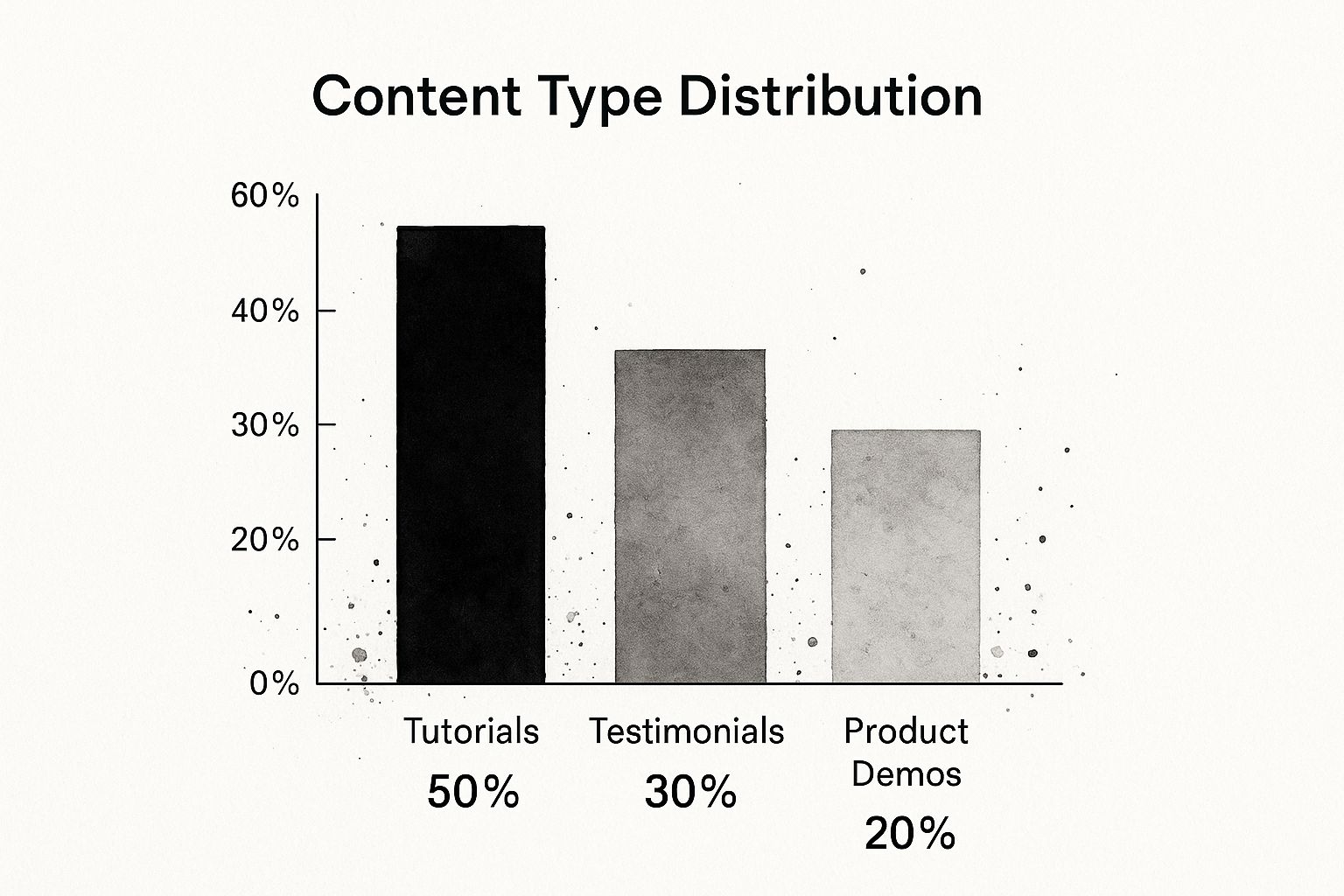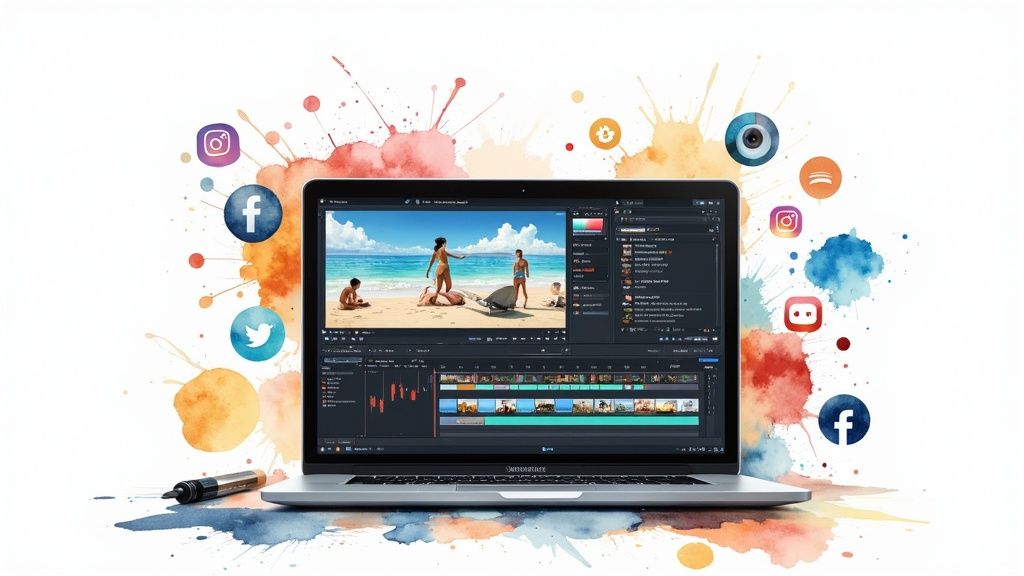Learn how to craft a winning video content strategy to drive engagement and maximize ROI. Discover expert tips to elevate your visual marketing today!
In This Article
Subscribe to our newsletter
Why Video Content Strategy Matters Now More Than Ever

Capturing and maintaining audience attention in today's digital environment is a constant challenge. This is precisely where a strong video content strategy becomes crucial. Video has evolved beyond a passing trend; it's now a fundamental element of successful communication in our visually-oriented world. It's no longer a "nice-to-have" but a "must-have" for businesses seeking to flourish.
The Shift Towards Visual Content
Consumer behavior has shifted significantly towards visual content. We're naturally drawn to engaging visuals, and video offers a dynamic, easily digestible format. Consider how quickly you scroll past text compared to how a compelling video can capture your attention. This preference for visual learning is evident on platforms like TikTok and Instagram Reels, showcasing the impact of short, engaging video content. This shift underscores the need for brands to adapt and prioritize video to connect with their audience.
The Competitive Edge of Strategic Video
Many companies treat video as an afterthought, creating sporadic and unplanned content. A truly effective video content strategy requires a proactive and thoughtful approach. Businesses that embrace this strategic approach gain a distinct competitive advantage. They're not simply creating videos; they’re building narratives, cultivating communities, and fostering deeper audience connections. This is the key differentiator between successful video marketers and those just creating noise.
This widespread adoption of video marketing is supported by data. By 2025, an estimated 89% of businesses will use video as a marketing tool, with 95% of video marketers recognizing its strategic importance. Find more detailed statistics here. This growth is driven by the substantial return on investment (ROI) video marketing delivers, with 93% of marketers reporting positive ROI from their video initiatives. Moreover, 96% of video marketers credit video strategies with increased brand awareness. These figures clearly demonstrate video's power in achieving tangible business results.
From Passive Viewing to Active Engagement
Traditional marketing often struggles to capture attention, resulting in passive consumption. Video, however, transforms passive viewers into active participants. Through interactive elements, compelling stories, and personalized messages, businesses can initiate conversations, encourage sharing, and build lasting relationships. This engagement translates into real results: increased conversions, higher traffic, and stronger brand loyalty. For businesses aiming to stand out and genuinely connect with their audience, a well-defined video content strategy is no longer optional – it's essential.
Building Your Video Content Foundation That Actually Works

Creating a successful video content strategy isn't about posting random videos and hoping for viral fame. It's about building a solid foundation that aligns with your business objectives. This section explores how successful brands create and maintain video strategies that get consistent, positive results.
Defining Meaningful Objectives
Before diving into video production, define clear, measurable objectives. These should directly support your overall business goals. Whether it's raising brand awareness, increasing sales, or driving traffic to your website, your video content strategy should serve a specific purpose. This means focusing on metrics like conversion rates and customer lifetime value instead of just chasing vanity metrics like view counts. For example, if lead generation is your goal, your video strategy might involve educational content that leads viewers to a landing page with a lead capture form.
Understanding Your Audience’s Video Consumption Journey
A strong video content strategy relies on understanding your audience. This means knowing their viewing habits, preferred platforms, and what kind of content resonates with them. Ask yourself: when do they typically watch videos? What type of content do they engage with? These insights will help you tailor your videos to meet their specific needs and expectations, ultimately leading to higher engagement and better ROI. Understanding their journey, from initial awareness to purchase, allows you to create videos that guide them through each stage.
You might be interested in: How to create video content for social media.
Developing a Unique Visual Identity
In a crowded online video landscape, having a unique visual identity is critical. Develop a consistent style for your videos, including elements like color palettes, fonts, and graphics. This creates brand recognition and makes your videos look professional and cohesive. It's like developing a signature style that makes your content instantly recognizable. This consistency also builds trust with your audience and reinforces your brand message.
Creating a Sustainable Video Calendar
Consistency is key for video content success. However, producing high-quality videos regularly requires planning and resource management. A realistic video calendar helps maintain a consistent posting schedule without overwhelming your team or budget. This involves establishing a clear production workflow, setting realistic deadlines, and allocating resources effectively. A structured approach helps maintain a consistent flow of engaging content, builds audience anticipation, and fosters a sense of community.
Crafting Platform-Perfect Video That Drives Engagement

The infographic above illustrates how different content types contribute to high-performing videos. Tutorials lead the pack, comprising 50% of this top-tier content. This highlights their effectiveness in engaging viewers and delivering valuable information. Testimonials and Product Demos also play a significant role, representing 30% and 20% respectively. This underscores the importance of a diverse video content strategy that addresses various audience needs and stages of the customer journey.
Tutorials, for instance, build trust and establish expertise. Testimonials offer social proof and bolster credibility. And product demos showcase the value proposition of your offerings.
Tailoring Content for Different Platforms
Creating compelling video content hinges on understanding the unique characteristics of each platform. What thrives on YouTube might fall flat on TikTok or Instagram. A successful video content strategy adapts to these differences. This goes beyond simply resizing videos. It requires tailoring your entire approach – from messaging and tone to video length and format.
Consider the platform's nuances. YouTube, known for longer watch times, supports in-depth tutorials and extended narratives. In contrast, short-form video platforms like TikTok and Instagram favor concise, attention-grabbing content. This emphasizes the need to right-size your content. For Instagram-specific guidance, check out this helpful resource: How to boost engagement on Instagram. On LinkedIn, a professional networking platform, concisely delivered thought leadership and industry insights resonate best.
Short-form video content continues its rise in prominence. This format delivers exceptional ROI across social media, with varying ideal lengths depending on the platform. For example, concise videos under 15 seconds perform well on Instagram and X (formerly Twitter). TikTok favors videos between 15-60 seconds. YouTube, however, supports longer-form content exceeding 60 seconds. Learn more about video statistics for social media here.
To help illustrate optimal video lengths, let's look at the following table:
Optimal Video Length by PlatformThis table compares the ideal video length across different social media platforms to maximize engagement.
| Platform | Ideal Short-Form Length | Ideal Long-Form Length | Best Performing Format |
|---|---|---|---|
| Under 15 seconds | Up to 60 seconds (Reels) | Reels, Stories, short-form videos | |
| X (formerly Twitter) | Under 15 seconds | Up to 2 minutes 20 seconds | Short, engaging clips |
| TikTok | 15-60 seconds | Up to 3 minutes | Trending sounds, creative effects, engaging narratives |
| YouTube | Over 60 seconds | No strict limit | Tutorials, in-depth reviews, vlogs |
| Under 60 seconds | Up to 2 minutes | Industry insights, thought leadership pieces |
As this table demonstrates, adapting your video length to each platform is critical for engagement. Shorter, impactful videos reign supreme on platforms like Instagram and X, while longer content finds its home on YouTube. Understanding these nuances allows you to tailor your videos for maximum impact.
Mastering Format-Specific Strategies
Different video formats serve distinct purposes in your overall video content strategy. Tutorials educate your audience and position your brand as an expert. Testimonials provide powerful social proof. Behind-the-scenes content humanizes your brand. Product demos showcase the value and benefits of your products or services. Each format plays a unique role in engaging your audience and guiding them through the sales funnel.
After establishing your core strategy, explore how to optimize individual videos for search. For deeper insights into video SEO, see this article on SEO technologies for video. Crafting platform-perfect videos involves aligning your content with the specific audience and culture of each platform. By understanding these nuances and tailoring your approach, you'll maximize engagement and achieve meaningful results.
Producing High-Impact Video Without Breaking the Bank
Creating compelling video content doesn't have to require a massive budget. Budget limitations shouldn't hold back your video content strategy. Many brands achieve impressive results with limited resources. This section explores practical strategies for creating professional-looking videos affordably.
Smart Equipment Choices
Professional equipment can enhance video quality, but it's not always necessary, especially when you're just starting. Surprisingly, today's smartphones offer excellent video recording capabilities. Often, a smartphone combined with a few budget-friendly accessories can suffice for producing high-quality videos.
Invest Wisely: Prioritize essential equipment. A good microphone and basic lighting setup should come before investing in expensive cameras. Audio quality is often more crucial than visual quality for keeping viewers engaged. Clear audio enhances the experience, while poor audio can quickly turn viewers away.
Smartphone Power: Use your smartphone's camera. Modern smartphones offer surprisingly good video quality. Pair your phone with affordable accessories like tripods, stabilizers, and external microphones to significantly improve your production value.
Maximizing Production Value on a Budget
Even with a limited budget, you can elevate your video production. Small changes in lighting and sound can make a big difference.
Lighting Magic: Natural light is a great resource. Film near windows during the day for a clean, professional look. Avoid harsh overhead lighting which can create unwanted shadows. Simple reflectors or inexpensive LED lights can drastically improve lighting.
Sound Matters: Invest in an external microphone. Clear audio dramatically impacts video quality. A lapel microphone or a small directional microphone can significantly improve sound. Minimize background noise by selecting quiet recording locations.
Affordable Editing Solutions
Professional video editing software can be pricey. Luckily, many free and low-cost options deliver excellent results.
Free Software: Explore free editing software like DaVinci Resolve or OpenShot. These platforms offer powerful editing features comparable to paid alternatives. They're a cost-effective way to create polished videos.
Mobile Editing Apps: Use mobile apps for editing on the go. Apps like InShot or CapCut offer various editing tools directly on your smartphone, simplifying the editing process.
DIY vs. Professional Help
Knowing when to handle video production in-house versus outsourcing is crucial for budget management.
DIY When Possible: For simpler videos, a DIY approach is often more cost-effective. This also allows for greater creative control and flexibility. When crafting your videos, remember to tailor your content for each platform, as this guide suggests on how to create videos for social media.
Strategic Investment: Consider professional help for more complex projects requiring specialized skills or equipment. This might include animation, motion graphics, or advanced visual effects.
By implementing these strategies, you can create high-impact video content without overspending. A compelling story and clear message are often more important than expensive equipment. Focusing on these core elements and smart resource allocation can maximize your video strategy's effectiveness.
Measuring What Actually Matters in Video Performance

Creating a successful video content strategy requires moving beyond superficial metrics like view counts. We need to delve deeper into data that truly reflects the impact of our videos on business objectives. This means understanding what metrics really matter and how they connect to actual results.
Beyond Vanity Metrics: Focusing on Actionable Insights
While views can give you a general sense of reach, they don't tell the whole story. Watch time reveals how long viewers are engaged with your content, while audience retention shows at what point they drop off. Click-through rates, meanwhile, indicate how effective your thumbnails and titles are at attracting clicks.
For example, a high click-through rate combined with low watch time might suggest your video isn't delivering on the promise of its title and thumbnail. On the other hand, strong audience retention indicates viewers find your content compelling. These insights allow for informed adjustments to your strategy.
Attribution Tracking: Connecting Engagement With Conversions
To understand the real impact of your videos, you need attribution tracking. This involves using tools like Google Analytics to connect video engagement with specific actions, such as website visits, product purchases, or sign-ups.
Imagine you're promoting a new product with a demo video. Attribution tracking can tell you how many viewers who watched that video ultimately purchased the product. This direct link between video engagement and conversions helps demonstrate the return on investment (ROI) of your video content.
Benchmarking and Continuous Optimization
How does your video performance stack up against others in your industry? Benchmarking helps answer this question by comparing your metrics to industry averages or competitors' performance. This process can reveal your strengths and weaknesses, guiding you towards continuous improvement.
Suppose your average watch time is significantly lower than the benchmark. This could signal a need to experiment with different video lengths or content formats. Benchmarking provides a valuable external perspective for refining your strategy.
Data-Driven Decision Making
Leading brands understand the power of data. They analyze video performance metrics to understand what resonates with their target audience. By identifying successful patterns – whether it's a particular video topic, format, or style – they can replicate those patterns in future content.
This data-driven approach is like A/B testing for your videos. It helps you discover what works best and maximizes the impact of your video content strategy. This also ensures that you’re not just creating videos for views but for tangible business outcomes.
Key Metrics to Track for Video Content Success
To build a truly effective video content strategy, you need to track the right metrics. The following table outlines key metrics for various marketing objectives.
To better understand how video content supports your overall business goals, here’s a breakdown of essential metrics:
Video Content Performance Metrics Framework
This table outlines the essential metrics to track for measuring video content effectiveness across different campaign objectives.
| Marketing Objective | Primary Metrics | Secondary Metrics | Tools for Measurement |
|---|---|---|---|
| Brand Awareness | Reach, Impressions, Social Shares | Website Traffic, Brand Mentions | Social Media Analytics, Google Analytics |
| Lead Generation | Click-Through Rate, Conversion Rate, Leads Generated | Watch Time, Audience Retention | CRM, Marketing Automation Platforms |
| Sales | Conversions, Revenue Generated, Customer Lifetime Value | Average Order Value, Cart Abandonment Rate | E-commerce Analytics, CRM |
| Engagement | Watch Time, Comments, Shares, Likes | Audience Retention, Click-Through Rate | Social Media Analytics, Video Platform Analytics |
By consistently monitoring these metrics, you gain valuable insights into audience preferences and the overall contribution of your videos to your business goals. This allows for a data-driven approach to optimization and ensures maximum impact. For more in-depth strategies, check out this resource on Video Content Marketing Strategies That Convert.
Future-Proofing Your Video Content Strategy
The online world is constantly changing, and your video content strategy needs to keep up. This isn't about chasing every new trend, but strategically using new technologies while staying true to core principles. Let's explore how successful brands are doing just that.
Emerging Trends and Technologies
New video tools and platforms are always emerging. AI-enhanced video personalization, for example, can tailor content to individual viewers, increasing engagement. Interactive video experiences, like polls and quizzes inside videos, create deeper audience interaction. Even Augmented Reality (AR) is making its way into video, blending digital and physical experiences. But remember, technology works best when it enhances, not replaces, good storytelling.
The Power of Authenticity and Storytelling
Technology is important, but authentic storytelling is still king. Audiences connect with real and relatable videos. Influencer Alix Earle's success, as covered by Sara McCord (read more about Alix Earle's content strategy), shows the power of authenticity. Earle's open approach, sharing both struggles and her support for small businesses, built a loyal audience.
This also means understanding your audience's expectations. While polished videos are important, an overproduced video can feel fake. The key is balancing professional quality with genuine connection.
Adapting to Platform Changes and Viewer Expectations
To future-proof your strategy, anticipate change. This involves:
Platform Agility: Be ready for new platforms. TikTok's rise shows how fast social media can change. What works on Facebook or YouTube might not work on TikTok or the next big platform. Diversify your content to avoid relying on a single channel.
Embracing Flexibility: Create a strategy that adapts. Experiment with different video lengths, styles, and approaches to see what your audience likes.
Continuous Learning: Stay updated on trends, but be strategic. By watching the digital landscape, you can take advantage of new opportunities. Remember, audience engagement is the ultimate measure of success.
By focusing on authenticity, adaptability, and continuous learning, you can build a thriving video content strategy.
Ready to improve your video creation? Aeon, an AI-powered video creation platform for publishers, helps you create engaging videos efficiently. Learn more about Aeon and how it can elevate your video strategy.


.jpg)